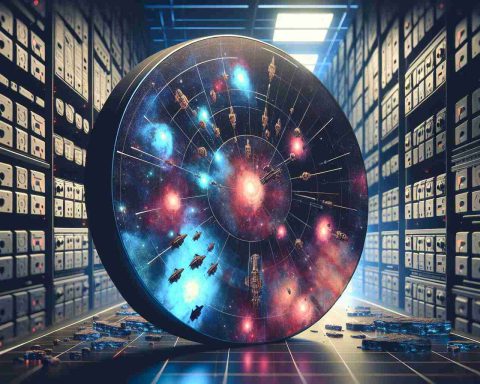- The FAA has initiated investigations into significant setbacks faced by SpaceX and Blue Origin.
- Blue Origin’s New Glenn rocket experienced technical issues during its inaugural stage, affecting telemetry data recovery.
- The unsuccessful booster recovery overshadowed Blue Origin’s achievement of reaching orbit on January 16.
- SpaceX is dealing with an explosion incident during a critical Starship test, under independent investigation.
- These incidents raise questions about the commercial space industry’s resilience and impact its ambitious timelines.
- Environmental concerns regarding space debris and atmospheric pollutants emphasize the need for sustainable practices.
- Ongoing challenges may drive innovations like recyclable propulsion systems, advancing responsible space exploration.
- The outcome of these investigations may lead to stricter safety measures for future missions.
In the vast arena of space exploration, even the giants stumble. In a dramatic turn of events, the Federal Aviation Administration (FAA) has launched an intensive investigation into significant setbacks faced by two space titans, SpaceX and Blue Origin. At the heart of this captivating inquiry is Blue Origin’s New Glenn rocket, which encountered technical snags during its inaugural stage recovery, raising alarms and freezing critical telemetry data mid-descent.
As the FAA scrutinizes these incidents, Blue Origin stands on the frontline, its next steps grounded until public safety is guaranteed. Despite achieving orbit on January 16—a feat only the tenacious strive for—the unsuccessful recovery of the booster casts a shadow over this achievement. Meanwhile, SpaceX grapples with its own turmoil after a dramatic explosion rocked its Starship during a pivotal test. Independent investigations into these incidents underscore a tumultuous period for commercial space exploration.
The repercussions of these failures ripple beyond the launchpad. As space exploration edges closer to becoming an integral part of our technological and economic future, these setbacks pose questions about the resilience of the commercial space industry and its ability to sustain ambitious timelines vital to sectors like telecommunications and global transportation.
Moreover, environmental concerns loom large. The interplay between space debris and atmospheric pollutants necessitates a shift towards sustainability. Here lies the silver lining: these challenges could spur innovations, such as recyclable propulsion systems, revolutionizing the industry towards responsible cosmic exploration.
As SpaceX and Blue Origin navigate these turbulent skies, their ability to surmount these obstacles will likely shape the future of space exploration. The unfolding investigations signal a shift towards more stringent safety measures, setting the stage for safer, more reliable missions bound for the final frontier.
Space Exploration in Crisis: What Lies Ahead for SpaceX and Blue Origin?
Pros and Cons of Current Space Technologies
Pros:
– Recent technological advancements have made it possible to explore space more efficiently and cost-effectively.
– Innovative projects from companies like SpaceX and Blue Origin aim to make space travel accessible to more than just astronauts, potentially opening doors to commercial space tourism.
Cons:
– The recent setbacks underscore challenges related to safety, reliability, and environmental impact. The unexplained explosions and technical failures could deter investors and slow progress.
– There is a growing concern over the accumulation of space debris and the carbon footprint of space launches, necessitating urgent strategies to mitigate these issues.
Features and Use Cases in Space Exploration
Features:
– SpaceX’s Starship is designed for long-duration cargo missions and human spaceflight, with a focus on landing astronauts on Mars and other celestial bodies.
– Blue Origin’s New Glenn rocket aims for a reusable design, promising more frequent and flexible launch capabilities.
Use Cases:
– Starship could enable rapid satellite deployment for enhancing global internet connectivity, serving sectors like telecommunications, agriculture, and disaster management.
– New Glenn offers potential in scientific exploration missions, space logistics, and even establishing a sustained human presence on the Moon.
Predicted Trends and Innovations
Trends:
– As safety and environmental demands rise, aerospace companies might shift towards developing eco-friendly technologies, such as sustainable rocket fuels and recyclable hardware.
– The commercial space sector will likely see increased competition, necessitating faster yet safer iterations of spacecraft technologies.
Innovations:
– The future could see advancements in AI and machine learning to improve the predictive maintenance of spacecraft, potentially avoiding incidents like those faced by SpaceX and Blue Origin.
– Developments in nanotechnology may offer more efficient materials for building spacecraft, making them lighter and more resource-efficient.
Key Questions and Answers
1. What are the main challenges currently faced by SpaceX and Blue Origin?
The main challenges include technical setbacks such as failed rocket recoveries and explosions, which pose questions about reliability and safety. Both companies also face environmental pressures related to space debris and pollutants from space launches.
2. How are these challenges impacting the commercial space industry?
Technical failures have led to scrutiny from regulatory bodies like the FAA, prompting a need for stricter safety measures. This environment slows down progress but also encourages innovations that could make space exploration safer and more sustainable in the future.
3. What are the companies doing to address these issues?
SpaceX and Blue Origin are focusing on independent investigations and advancements in their technologies. This includes developing more reliable recovery systems and exploring environmentally responsible propulsion technologies to minimize ecological impact.
For more information on these companies, visit [SpaceX](https://www.spacex.com) and [Blue Origin](https://www.blueorigin.com).














